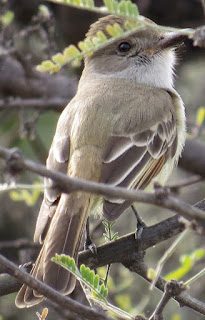This past
Wednesday I had the opportunity camp for a night and go birding and botanizing
with some friends of a friend. Nina, Galen, and Amelia are past or present
students at Whitman College, and this was their last week of enjoying the
out-of-doors on their winter break. I chose to take us to the lowest reaches of
California Gulch on the Mexican border to look for the Nutting’s Flycatcher
found on the Atascosa Highlands CBC by my friends Dave Stejskal and Thomas
Staudt. Amelia chose to hang back in Tucson to work on her undergraduate
thesis, so it was just Nina, Galen, and I.
We arrived
at one of my favorite camping spots at the confluence of California Gulch and
Warsaw Canyon, where two years ago I heard a Buff-collared Nightjar on the
early date of March 31. This time we heard just Western Screech-Owl, Great
Horned Owl, and Coyotes. In the morning we began birding our way downstream
about 1/2 mile to where the Nutting’s Flycatcher had been seen.
We didn’t
find it right away, in fact an Ash-throated Flycatcher was at the exact spot
when we arrived. We took this opportunity to study the features on the
Ash-throat that would be different if we were to find the Nutting’s – the color
of the belly, the pattern of rufous vs. fuscous visible on the underside of the
tail (on the outer tail feathers), the edging on the primaries and secondaries,
and the color and shape of the crown and its contrast with the face. The
Ash-throat was calling too, which is the easiest way to tell them apart. But we
didn’t stand around just waiting, knowing that the bird had been seen quite a
ways downstream in the past days. We also preferred to explore, making it as
far as the Mexican border, about 3/4 mile farther down the canyon. We said hi to the two Mexican military guys who had
camped on their side, on a regular patrol it seemed. We exchanged a few
friendly words and made our way back to the flycatcher area.
Here’s a view
looking southwest up at the fence line that is the international border, and
the overgrazed Mexican side is more evident than the fence itself. No, there’s
no wall here as you can see, and nor need there be one.
We finally
found the Nutting’s Flycatcher at about 11:00 a.m., after some 2 1/2 hours of
searching. It never vocalized, and we were lucky to find it about 1/4 mile away
from the original location, upstream from where others had seen it. This is
Nina’s photo showing the darker yellow belly, the yellow- and cinnamon-edge
secondaries (rather than creamy white in Ash-throated), as well as the rounder
and richer brown crown that bleeds into the ear coverts and face (which are all
grayer in Ash-throated and blend more with the throat). These are very subtle
points, and it was a good thing we had practiced on the Ash-throat.
Lucky for
me, both Galen and Nina were interested in everything and enjoyed just poking
around, looking at plants and bugs. This cactus is Echinocereus fendleri var. rectispinus,
the Pink-flowered Hedgehog. It blooms in spring.
This is the common
Ferocactus wislizeni, Candy Barrel or
Fire Barrel. This one blooms in the summer, but I don’t know if the scarring in
the crown will affect that.
We had two
very distant flickers. The first one I used playback to see it fly, and I
glimpsed the yellow wing linings. My poor photo also shows the bright cinnamon
cap of Gilded Flicker.
Galen
spotted this very distant one later in the day, and thanks to a camera with 65x
optical zoom, you can see the red tail shafts of a Northern Flicker. The crown
is also browner and doesn’t extend as far back.
You wouldn’t
know it in the summer time, but one of the dominant shrubs here is Forestiera shrevei, the Desert Olive,
which I first identified last year on the Buenos Aires NWR CBC (http://birdernaturalist.blogspot.com/2016/01/the-san-luis-wash-on-buenos-aires-nwr.html).
They are in full bloom now before putting on leaves, and they really stand out.
They were also swarming with pollinators, largely honey bees as many of these
native bees which appear to be some mining bee in the family Andrenidae. I’ll
post an update here if my photos on Bugguide are identified. The bees on these
bushes seem to be the primary food source for the Nutting’s Flycatcher.
Update 1/18/17 : bee expert John Ascher has identified this for me as the mining bee Andrena impolita, Unpolished Andrena.
Update 1/18/17 : bee expert John Ascher has identified this for me as the mining bee Andrena impolita, Unpolished Andrena.
We saw two
very different red-bodied wasps. This one is a parasitoid Ichneumonoid wasp,
either family Braconidae or Ichneumonidae. Update 1/18/17: Entomologist and parasitoid expert Ross Hill has identified this for me as an Ichneumonid in the genus Cryptus.
This red-bodied
wasp is in an entirely different family, but I don’t know which. I thought it
might be a spider wasp in the family Pompilidae, but I’m not so certain now, and
I wonder if it might be a male velvet ant (distantly related and in the same
superfamily as spider wasps). Update 1/19/17: John Ascher has struck again, conclusively identifying this one as Xerochares expulsus, which confirms my original suspicion as a spider wasp – family Pompilidae (and continues down the line of classification in the subfamily Pompilinae and tribe Pompilini). It appears to be a monotypic genus found throughout Central America, reaching the US only in the desert SW, and as of a 1985 monograph on the subfamily in California nothing was known of its biology.
The
landscapes here near the border are stunning, where drainages lead south into
the Rio Magdalena watershed (unlike a vast majority of Arizona, which flows out
the Colorado River). This is looking to the northeast back up California Gulch
with Montaña Peak on the far left.
Here is
looking to the southeast; Flat Top Mountain just right of center is just barely
on the Arizona side of the border.
We climbed
to a small peak and enjoyed the views.
-->
This is a
180° panorama taken with my phone.





















No comments:
Post a Comment